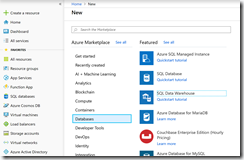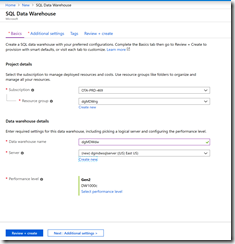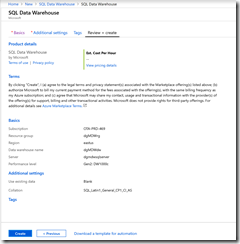A data warehouse ("DW") is an ideal tool for collecting and associated disparate data.
A data warehouse has been a part of Microsoft SQL Server for decades, so it's not surprising that it is also included in Microsoft Azure.
To create a SQL Data Warehouse in Azure, navigate to the Azure Portal, sign in, and click the [Create a resource] button (Fig. 1).
From the menu, select Databases | SQL Data Warehouse, as shown in Fig. 2
The "SQL Data Warehouse" dialog displays, allowing you to enter information about your new data warehouse, as shown in Fig. 3
At the "Subscription" field, select the subscription in which you wish to create this data warehouse. Most of you will have only one subscription.
At the "Resource group" field, select an existing resource group or click the "Create new" link to create a new resource group in which to add this data warehouse. A resource group is an organizational unit to keep together related Azure resources.
At the "Data warehouse name" field, enter a unique name for your warehouse.
The "Server" field lists all SQL servers in the selected subscription. Every data warehouse is stored in one SQL Server. Select the SQL Server for this DW or click the "Create new" link to create a new SQL Server.
Clicking "Create new" displays the "New server" blade, as shown in Fig. 4. In this blade, you can enter the server name, location, and admin login credentials for a new server.
Click the [Review + create] button to display the "Review + create" tab of the "SQL Data Warehouse" dialog, as shown in Fig. 5.
Click the [Create] button to create a new SQL Data Warehouse. This process may take a few minutes (longer if you also chose to create a new server).
After the Data Warehouse creation is complete, you can navigate to its management page. The "Overview" blade is shown in Fig. 6.
In this article, you learned how to create a new Azure SQL Data Warehouse.




